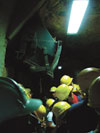

Modern mining companies recognise that their investment in security solutions pays dividends in terms of reducing risk and preventing losses. Tommy Laubscher, general manager customer support in the technical division of Protea Coin Group, has worked in mining security for almost 20 years. He says that all the best run mining groups are committed to investing in security solutions that can deliver consistently reliable results in terms of managing risk and preventing losses.

Laubscher divides mine security into two overall functions: access and surveillance. “In broad terms, mining companies firstly need solutions that can control who can do what, where and when. This is all about access control across a range of different activities and goes way beyond simply managing who is allowed through the main gates.
“Secondly, mines also need to be able to remotely monitor what is happening across various aspects and areas of their operation. They need to see what is going on and this is why CCTV systems are so important.”
These two functions are quite different in terms of the technology they use, how that technology is applied, the way it is managed and the results it delivers. These differences also mean that responsibility for their operation is not limited to just one area of management.
Laubscher explains that, “CCTV systems are normally controlled by the security department as part of their physical security surveillance system. However, the role of managing an access control system is typically split between the security department and the HR function. And the outcomes they require are not the same. For example, HR may need information from the access system to record attendance and hours worked.
“In turn, HR may use this information within payroll to manage salaries and wages. It is easy to see why paying employees is not the direct responsibility of the security team. Nevertheless, the payroll function is still dependent on the access system to which it is linked for accurate data.”
The business case for running an integrated access control and time management solution is quite clear. A single solution can handle both requirements. There is no need to run two separate systems alongside one another.
Maximise business results
Laubscher sees the technical advances in modern access systems as providing a win-win investment for secure business solutions in mining. “Our SACO product range has for several years incorporated fingerprint scanners as a consistently accurate way to identify authorised employees. From a security perspective, fingerprint identification is far more secure than using traditional access cards because people cannot share them.
“At the same time, by replacing cards with fingerprint scanners we can really improve the accuracy of the data that our access system supplies to HR for their purposes. We can completely prevent buddy clocking and the losses it causes as well as the operational risks it creates.”
Access cards can so easily be exchanged between individuals and this causes a major concern regarding illegal mining and theft issues we are experiencing in the industry. More and more mining groups are nowadays moving in this direction to secure their access points with biometric readers.
To further illustrate his point that modern security systems are not solely concerned with controlling access, Laubscher gives the example of how such systems can monitor an environment such as a canteen. “Of course, we want to restrict access to canteens and ensure that the meals they supply are only served to duly authorised individuals working on the mine. But at the same time we can monitor calorie-intake from a health management perspective. Once again, these are not conventional security issues.”
The demand for integrated solutions
In terms of unified solutions that can manage different security functions, Laubscher says, “All the leaders in mining are more and more focused on purchasing and implementing turnkey solutions. This means that mining companies are looking for one supplier to provide and maintain their access control, CCTV and alarm systems. Standalone systems that only offer specific benefits in isolation are no longer of interest to the mining industry.”
Online record keeping and real-time information has become a necessity for managing emergency situations where it is critical to have accurate knowledge of who is where. The same is true for high-risk, daily operations like shaft clearances before underground blasting takes place.
Based on his experience, Laubscher knows full well that the idea of integrating solutions is a lot easier to talk about than it is to achieve. Not all systems are fully compatible and getting them to work reliably together can be costly. However, these once-off costs need to be compared to the recurring costs and risks of operating with different products and systems from various suppliers on the same site.
It is also important to understand that, unlike an office park, a mine uses many different types of security-related systems in addition to those for access control and time management. As Laubscher says, “Integration between different systems is not as easy as spelling the word. When different solution providers and suppliers are involved it can complicate the integration process to such an extent that some of the systems might have to be totally replaced.
“For example, legacy systems supplied to the market may have a closed data base set whereas most systems today have an open database structure such as MS SQL. It is much easier to integrate systems that share common functionalities. Most mines would love to have all their systems integrated onto one application and some of the mine groups have already managed to reach this goal.”
We still need people
Laubscher stresses that providing an overall security solution for a mine cannot be limited to using the latest advances in integrated technologies. “Security guards are an essential element of visible, human security and will always play a large part to deter and prevent crime.
“Patrolling miles of a perimeter fence and managing entry points is still very much an essential job for the security team. The only way to safeguard a mine successfully is to combine the two. You need technology working alongside well-trained security staff.”
For more information contact Protea Coin, +27 (0)12 665 8089, [email protected]

© Technews Publishing (Pty) Ltd. | All Rights Reserved.